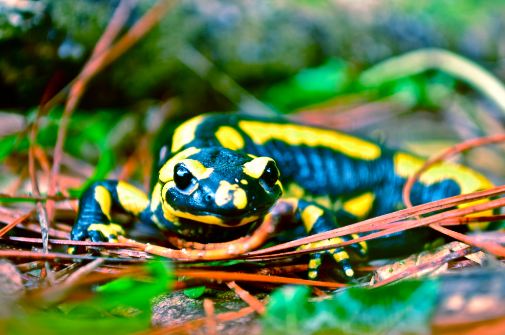How to Care for a Spotted Salamander – Spotted salamanders are among the largest types of salamanders, reaching an average of 6 to 7 inches in length – but some grow as long as 10 inches. They have a lifespan of about 25 years, which you should consider if you are considering if you want to keep one in captivity. Spotted salamanders are usually black with two lines of yellow spots on each side of the rear, but some have a blue tint or have gray or brown skin.

Do not handle salamanders unless absolutely necessary because their skin is very easily damaged. If you need to handle your own, wash your hands first, and rinse them with cold water. Leave your hands moist to protect the skin, and keep the time of manipulation as short as possible to keep the salamander from becoming overheated by the warmth of your body.
Habitat setting
Spotted salamanders do not require a large habitat as they stay in a very small beach in nature. A 10-gallon aquarium is enough for one or two. The most important part of the habitat provides many places for him to burrow and hide. A thick layer of substrate that is a free and easy to keep wet chemical is a must. Some good choices include potting soil, pine bark soil, sphagnum moss and coconut fibers. Place enough in the tank to make several inches deep. Include small logs, driftwood pieces, large chunks of bark from trees or living plants to allow many places to hide. Lightly spray the substrate with water every day to ensure that it is always moist, as is the source of the salamanders ‘ water intake and is also necessary to protect their delicate skin.
Keep the habitat in a room that is between 50 and 70 degrees Fahrenheit. It is essential to avoid temperatures above 75 degrees to avoid drying the substrate and skin of salamanders.
Dietary needs
A spotted salamander needs to eat only three times a week and enjoy a diet consisting of crickets, earthworms and an occasional baby mouse. Get the food from a reputable pet food supplier away from chemicals or unwanted diseases. Since the salamander absorbs water through the skin from the substrate, use only distilled water. Tap water may contain harmful chemicals.
Breeding habits
Salamanders breed once a year in the wild. The male is involved only in fertilization and provides no care after. Female deposit eggs, which are enclosed in a gelatinous substance, on an object that is underwater. On average, they lay 100 to 300 eggs per year. The eggs hatch between four and seven weeks later. It is very unlikely that a spotted salamander in captivity will lay eggs.
Healthcare
Many veterinarians are not educated on spotted salamander care, so it is important to find a veterinarian with an exotic animal experience. Symptoms that may mean the disease in a spotted salamander include:
- Decreased appetite
- Bloating
- Difficult breathing
- Lethargy
- Skin Lesions
- Dull eyes
- Diarrhea
If your salamander shows spotted one of these symptoms or just doesn’t seem right, go with a qualified veterinarian immediately.
